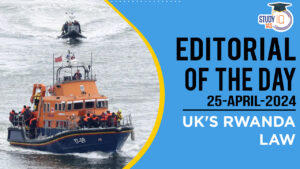Daily Current Affairs for UPSC 2023
Q) Recently seen in news, the ‘Swabhiman Anchal’ is related to which one of the following states?
- Bihar
- Odisha
- Telangana
- Madhya Pradesh
Daily Current Affairs for UPSC – 7 April 2023
Explanation:
- Option (2) is correct: Swabhiman Anchal has created transformations in Odisha, which can serve a transformation model for other districts as well. In 2018, the Odisha CM inaugurated the Gurupriya Bridge over the Balimela Reservoir, ending the isolation of the region. He renamed the region as ‘Swabhiman Anchal’, which means Self-Respect Zone, and announced a special package of Rs 100 crore under the SETU (Socio-economic Transformation and Upliftment) scheme for the development of this Maoist stronghold. Other projects, including mega piped water supply project, construction of mobile towers in the area, have helped the residents of Swabhiman Anchal join the mainstream. As infrastructure of Swabhiman Anchal got better, development programmes were pumped in and the security forces won the confidence of the people, left-wing extremists (LWEs) retreated. The people of Swabhiman Anchal, who were earlier perceived as sympathizers of the outlawed Communist Party of India (Maoist), seemed to interact with the officers without any fear. The people have aired their grievances to officers and gave suggestions for improvement in the region.
Q) Consider the following statements about ‘Cannabis’:
- ‘Cannabidiol’ is the main psychoactive compound in cannabis.
- Himachal Pradesh is the first state in the country to legalise cannabis cultivation for industrial use.
Which of the statements given above is/are correct?
- 1 only
- 2 only
- Both 1 and 2
- Neither 1 nor 2
Explanation:
- Statement 1 is incorrect: Cannabis refers to a group of three plants with psychoactive properties, known as Cannabis sativa, Cannabis indica, and Cannabis ruderalis. Cannabis is made up of more than 120 components, which are known as cannabinoids. Cannabidiol (CBD) is a psychoactive cannabinoid, yet it’s non-intoxicating and non-euphoric. It’s often used to help reduce inflammation and pain. It may also ease nausea, migraine, seizures and anxiety. Tetrahydrocannabinol (THC) is the main psychoactive compound in cannabis. THC is responsible for the “high” that most people associate with cannabis. India banned the cultivation of cannabis plant under the Narcotic Drugs and Psychotropic Substances (NDPS) Act. Currently, charas, ganja, or any mixture or drinks prepared from the two products are banned in India under the NDPS Act, regardless of hemp cultivation.
- Statement 2 is incorrect: Uttarakhand became the first State in the country to legalise cannabis cultivation in 2017 for industrial use. Central government has also given legal status to the cultivation of cannabis in some districts of Rajasthan, Madhya Pradesh and Uttar Pradesh. Controlled cultivation of cannabis has been permitted in several European Union countries apart from Uruguay, Canada, USA, Austria, Belgium and the Czech Republic. Himachal Pradesh assembly has constituted a committee of legislators to look into legalisation of cannabis cultivation in the state.
Q) Consider the following statements about ‘software as medical device’ (SaMD) and ‘software in medical devices’ (SiMD):
- SiMD is standalone software that offers medical data to assist in medical decision-making.
- SaMD is an integral part of a hardware medical device and helps provide a specific medical treatment.
- The software that controls the functions of pacemakers is an example of SiMD.
Which of the statements given above is/are correct?
- 1 and 2 only
- 2 and 3 only
- 3 only
- 1, 2 and 3
Explanation:
- Statement 1 is incorrect but statement 3 is correct: Software in medical devices (SiMD) refers to the software component of a medical device that is intended to provide control or guidance of the device’s function. It is an integral part of a hardware medical device and is designed to work with the device to provide a specific medical function or treatment. Examples of SiMD include software that controls the functions of pacemakers, infusion pumps, or diagnostic equipment. Experts have recently warned that many personal use medical technology devices containing software can leak data that can breach the privacy and cause cyber-security threats.
- Statement 2 is incorrect: Software as medical device (SaMD) is software that is intended to be used for medical purposes without being part of a hardware medical device. It is typically standalone software and its primary function is to provide medical information, support medical decision-making, or provide therapy or diagnosis to patients. Examples of SaMD include clinical decision support systems, mobile medical apps, and medical imaging software. These devices are capable of collecting and transmitting sensitive health data, such as medical histories and personal identification information, which can be targeted by hackers in the event of a data breach. These devices are usually connected to the internet, mobile phones, servers, and the cloud and vulnerable to malware and virus attacks.
Q) With reference to ‘LIGO-India Project’, consider the following statements:
- LIGO is an international network of laboratories that detects neutrons produced by the celestial objects.
- The project is being set up in the Theni district of Tamil Nadu.
Which of the statements given above is/are correct?
- 1 only
- 2 only
- Both 1 and 2
- Neither 1 nor 2
Explanation:
- Both statements are incorrect: The LIGO-India project will be set up in Hingoli district of Maharashtra and will start scientific runs from 2030. LIGO is an international network of laboratories that aim to detect ripples in space-time (gravitational waves) produced by the movement of large celestial objects like stars and planets. Space-time encapsulates the current understanding of how gravitation works. It was first postulated in Albert Einstein’s General Theory of Relativity. The detector will be built as part of LIGO-India collaboration. This will be the sixth LIGO project, with two already existing in the US, two in and one in Japan. LIGO comprises two 4-km-long vacuum chambers, built perpendicular to each other. Highly reflective mirrors will be kept at the end of the vacuum chambers. Light rays are simultaneously released in both the vacuum chambers. They hit the mirrors, get reflected, and are captured back. Under normal circumstances, the light rays in both the chambers would return simultaneously. But when a gravitational wave arrives, one of the chambers gets a little elongated, while the other one gets squished a bit. Due to this effect, light rays do not return simultaneously, and there is a phase difference. The presence of a phase difference marks the detection of a gravitational wave.
Q) Consider the following statements about the ‘TEMPO’ device:
- It was recently launched by the European Space Agency into geostationary orbit.
- The device helps measure pollution and air quality across the countries of the European Union.
- The device will measure the concentration of nitrogen dioxide, ozone, and formaldehyde in the air.
Which of the statements given above is/are correct?
- 1 only
- 1 and 2 only
- 2 and 3 only
- 3 only
Explanation:
- Statement 1 and 2 are incorrect but statement 3 is correct: The TEMPO device was launched on a SpaceX Falcon 9 rocket mounted on a geostationary satellite, which means it orbits the Earth at the same speed as the planet’s rotation, allowing it to remain in a fixed position over North America. TEMPO will be able to measure the concentrations of various air pollutants, including nitrogen dioxide, ozone, sulfur dioxide, formaldehyde, and aerosols. The instrument will measure pollution and air quality across greater North America on an hourly basis during the daytime all the way “from Puerto Rico up to the tar sands of Canada.” This high level of detail is expected to improve our understanding of the sources and movement of pollution, as well as help policymakers develop more effective strategies for reducing it. The data will be used by the US Environmental Protection Agency (EPA), the National Oceanic and Atmospheric Administration (NOAA) and other agencies responsible for tackling atmospheric pollution. A unique feature of TEMPO, which is about the size of a washing machine and has been described as a chemistry laboratory in space, is that it will be hosted on an Intelsat communications satellite in geostationary orbit.


 Current Affairs 25th April 2024 for UPSC...
Current Affairs 25th April 2024 for UPSC...
 Editorial of the day (25th Apr): UK's Rw...
Editorial of the day (25th Apr): UK's Rw...
 Telangana Judicial Recruitment Notificat...
Telangana Judicial Recruitment Notificat...

















